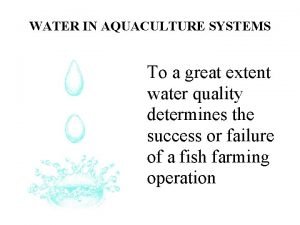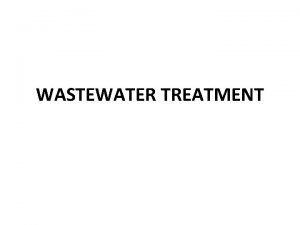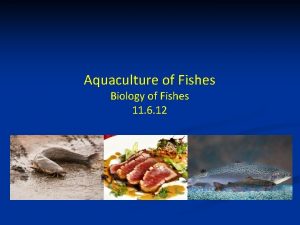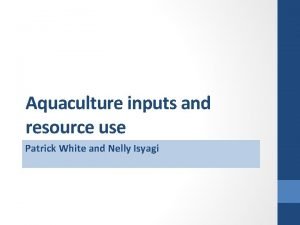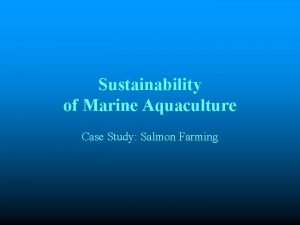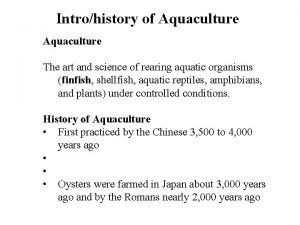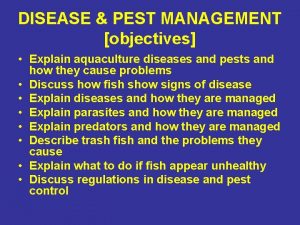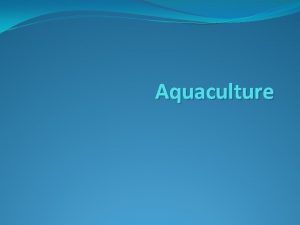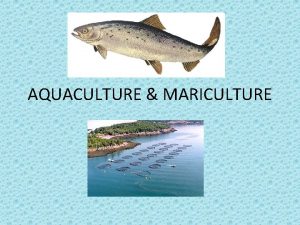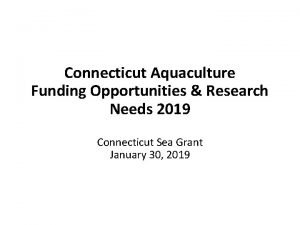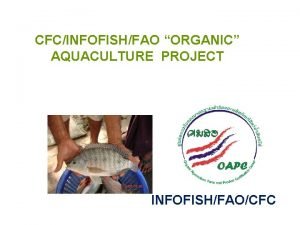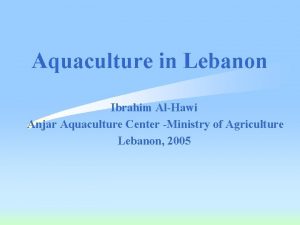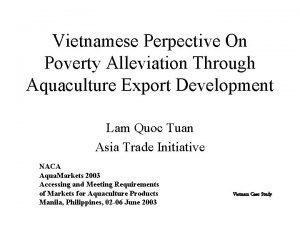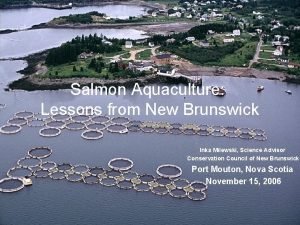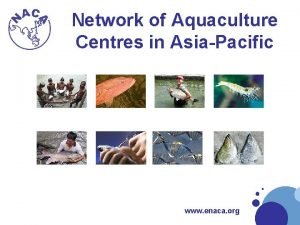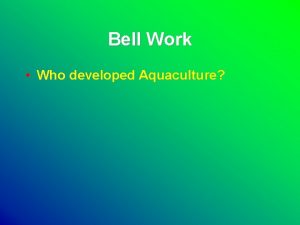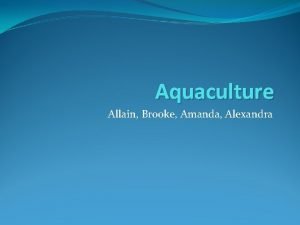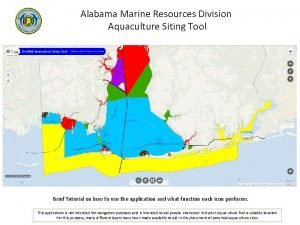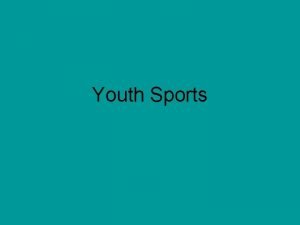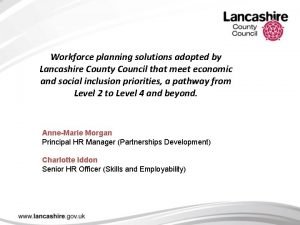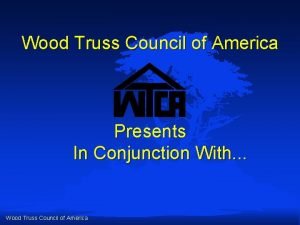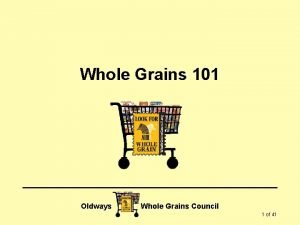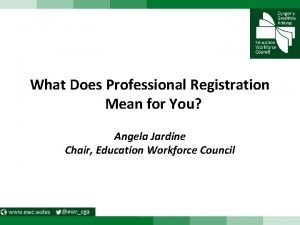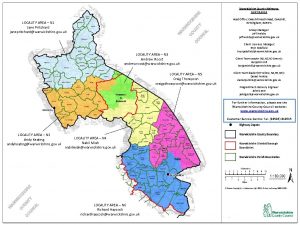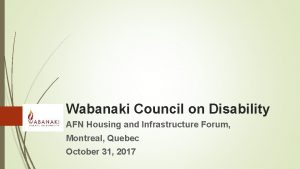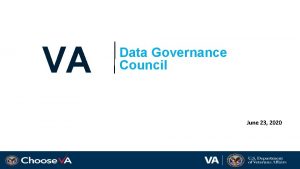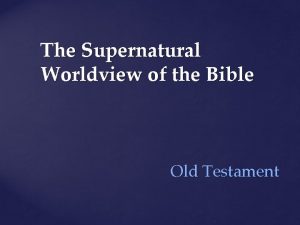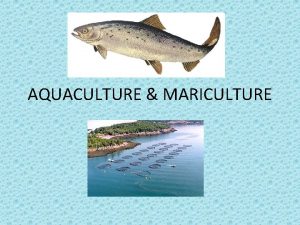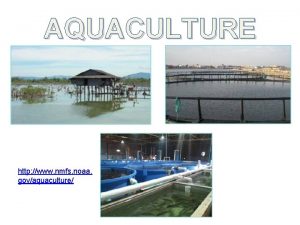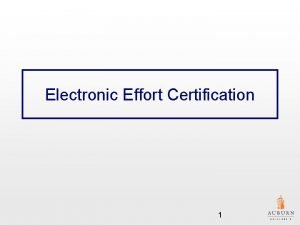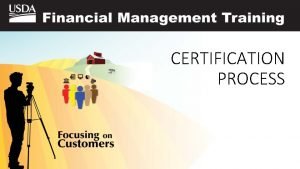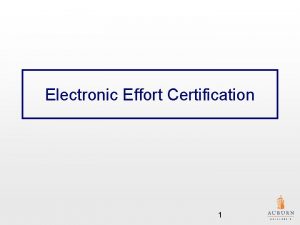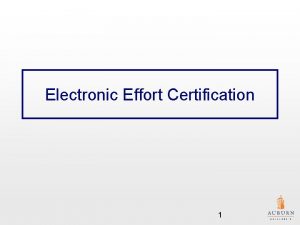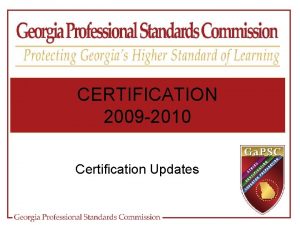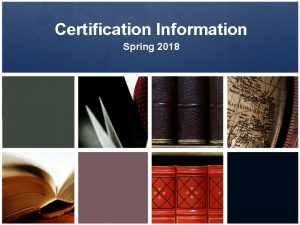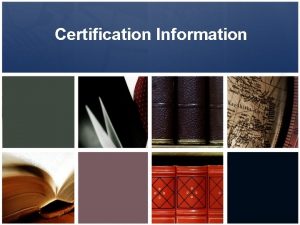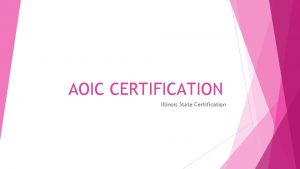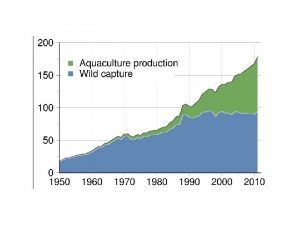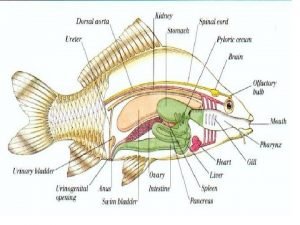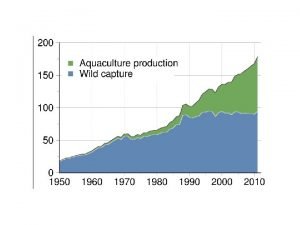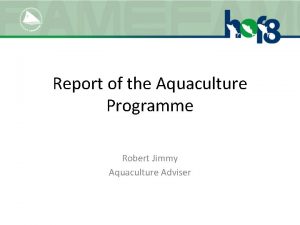Aquaculture Certification Council Inc www aquaculturecertification org Aquaculture


































- Slides: 34

Aquaculture Certification Council, Inc. www. aquaculturecertification. org

Aquaculture Certification Council, Inc. Independent Non-profit Non-member public benefit corporation established in January 2003. -- Adopted Responsible Aquaculture Codes of Practices to establish standards for process certification of aquaculture facilities. Mission - To improve supply and safety of aquaculture products from producers and processors and to promote the education and advancement of scientific knowledge related to the aquaculture industry.

Uses elements of GAA Responsible Aquaculture Practices to establish standards that can be applied to the industry to assist farms and processing plants in dealing with environmental and social concerns and food safety concerns of the consumers.

Why Certification Is Important Program addresses the growing concern of consumers, buyers and NGOs regarding food safety and environmental/social issues. Certification of responsible aquaculture practices is necessary to compete in today’s market with new demands and low prices.

Certification Process Encompasses onsite inspections and audits to verify participants are in compliance with aquaculture practices that assure food safety, social responsibility and sustainable productions methods. Process certification with orientation toward seafood buyers. Program is practical to implement and accessible to large or small operations. Program is buyer oriented and market driven. Certification is designed to solidify consumer confidence in the safety of certified aquaculture product, satisfy growing environmental concerns and social issues concerning workers safety and standards.

Responsible Aquaculture Program The Evolution from GAA Gathering Facts Codes of Practice Current – Farms and Processing Plants Future – Hatcheries and Feed Plants Future – Other Aquaculture Species Quantitative standards – Developed by an Oversight Committee External Review of Standards 2 year process Industry, Regulators, Academia, NGOs, Stakeholders

Aquaculture Certification Council, Inc. Formed to Conduct Certifications Shrimp Farms – Now Processing Plants – July Feed mills – 2004 Hatcheries – 2004 Other Aquaculture Species - 2004

Program Development Environmental and Social Guiding Principles for Responsible Aquaculture Codes of Practice for Responsible Shrimp Farming and Processing Quantitative Standards for water quality effluents, and solid waste and sediment management. Food Safety Biological pathogens Antibiotics Chemical hazards and Pesticides Traceability

Program Orientation Product Certification ¨ High liability Consumer Label Complex labeling Expensive consumer education Counterproductive to alert consumer about issues n Process Certification ¨ Minimal liability ¨ Satisfies environmental and social concerns of regulatory agencies (FDA, Department of Agriculture)

Program Orientation Buyer Orientation No retail labeling (Logo at wholesale level) Keeps sensitive issues within buyer/seller community. Program driven by demand from buyers who are driven by consumers. Client (Farm) Orientation Addresses sensitive issues within industry (Govt. agencies, NGOs, effluent sediments, contaminants)

Activities Train and accredit independent (3 rd party certifiers) Wrote and revised aquaculture standards for process certification of farms and soon processing plants, hatcheries, and feed plants. Establish and maintain traceability database to assure compliance with food safety standards.



Hatchery Registration with government – certified by ACC. Use certified disease free post-larvae from hatchery. Do not import non-indigenous species without government approval – must be certified as disease free. Responsible disposal and treatment of waste and effluents. Properly acclimate postlarvae and verify as disease free before stocking. Destroy diseased animals. Do not use illegal and banned chemicals and antibiotics in production process.

Farms Site farms to avoid significant technical environmental and social problems to ensure projects are harmoniously integrated into local environmental and social settings. Design farm and construct to overcome site limitations and to prevent negative environmental and social impacts. Protect environment, especially mangroves from adverse impacts of farming practices. Legal land ownership – documented permission to operate. Responsible pond operations to protect environment quality and enhance sustainability. Use approved chemicals only, no banned antibiotics. Good quality feed – no live feed, uncooked feed or organic fertilizers. Avoid excess use of fertilizers and overfeeding. All water shall meet quality standards before being discharged.

Farms Cont. Minimize exchange rates, do not mix fresh water with salt water. Use good health management protocols to manage stress and diseases. Dispose of sediments and wastes responsibly to enhance protection of coastal land, water resources and public health. Containments should be built to prevent fuel spills. Proper screening of water being pumped and discharged. Control sedimentation of discharge water. Inlet and discharge canals should be separate so water supply and effluent are not mixed. Use healthy hatchery larvae rather than wild-caught larvae. Promote responsible effluent management and discharge based on International Codes of Practices.

Community, Labor, Human Rights Hire local workers – fair compensation. Safe, healthy working conditions. Respect child labor laws – respect human rights. Take steps to train workers and protect employee health and safety hazards. Respect the environment and regulations regarding the rights of local people to use coastal resources. Support local community and public health programs and provide suitable working and living conditions for workers living on facilities. Work with government and NGO organizations to avoid conflicts and misunderstandings. Respect use of land, resources and environment of local communities.

Feeds and Feed Use Promote feeding efficiency of supplemental feeds to minimize waste load in ponds. Store feed in dry areas to prevent mold and other contamination. Do not feed contaminated feed. Medicated feed should be used only if necessary for the control of a specific diagnosis of diseases. Feeding of uncooked organisms such as fish and invertebrates in prohibited because they carry diseases and foul pond waters. Feed ingredients should be tested to verify they are free of contaminants, microbial toxins and adulterating substances.

Harvest and Transport Proper icing and handling of shrimp to maintain quality. Prompt delivery to processing plant. Sanitary working conditions at receiving or depot facilities. Do not use unsafe chemicals to treat shrimp. Transport shrimp under safe conditions to avoid contamination from fuels, oils and contaminants.

Processing Plants Processing plants must comply with local and national laws including those related to product exportation. Processing plants must comply with local and national labor laws to assure worker safety and adequate compensation. Processing plants must dispose of process water and sewage in a responsible manner that does not create pollution, cause excessive odor or spread disease. Fuel, lubricants, plant chemicals and potentially dangerous compounds must be properly labeled, stored, used and disposed of in a safe and responsible manner.

Processing Plants Cont. Processing by-products and garbage must be disposed of in a sanitary, responsible and bio-secure manner. Processing plants must have a current HACCP plan and process control program that includes preventative measures to control food hazards and ensure product safety. Production process controls and ensures product quality. Accurate records that establish product traceability and identity must be documented.

Shrimp Farm Certification

Farm Certification Standards Community 1. Property rights and regulatory compliance 2. 3. Community relations. Worker safety and employee relations. Environmental 4. 5. 6. 7. Mangrove conservation Effluent management Sediment management. Soil/water conservation. 8. Postlarvae sources. 9. Storage & disposal of farm supplies. Food Safety Drug & Chemical Management 11. Microbial sanitation 12. Harvest and Transport 13. Records for product traceability 10.

Certification Procedure Facility submits certification application form and application fee to ACC Facility selects certifier and contracts inspection Site inspection and effluent sampling Facility pays entry participation fee that is based on facility production. Certified facility issued unique ID and listed on ACC website Facility maintains records Facility is audited by ACC for compliance yearly and recertified if audit is passed.

Processing Plant Certification

Processing Plant Certification Standards Community 1. Community - Regulatory Compliance. 2. Community - Worker Safety and Employee Relations 3. Environment 3. Effluent Management 4. Storage and Disposal of Plant Supplies 5. Waste Management Food Safety 6. Food Safety and Quality Assurance. 7. Record Keeping Requirements for Traceability and Product Verification

Traceability Need to track all aspects of product history from egg to table Everything that is certified must be traced. A live database system is being established for Certified shrimp

Traceability Old Paradigm: Inspect for defects at end Microbiological of production process ? ? contamination Antibiotic residues Environmental Issues Social Issues

Traceability New Paradigm: Implement standards and traceability at each step of process Feed Manufacturing Quality Assured Pond Growout Hatchery Processing


Fees Certification Application Fee: $500 Inspection Fee for Certifier Paid by farm, processing plant, feed mill, hatchery, or analytical lab. $400 -800/day plus travel expenses of inspector Participation Fee (Farm) - Based on production ranges from $500 - $6, 000 per year based on $1. 00 per metric ton. Participation Fee (Plant) – Based on facility’s annual export of farmed shrimp. $2, 000 for up to 1 thousand metric tons and $2. 00 per metric ton thereafter.

What the ACC Program Offers Process Certification for Food Safety. Traceability Verification with record management and Logo Use. Container Verification and testing for Food Safety Audits for Verification of Compliance Listing on Website for Certified Facilities Better Quality Product Through Codes of Practices at Farms and Processing Plants

More the ACC Offers Program that is practical to implement and financially accessible to small farms and plants. Program that can be audited and verified by trained professionals to assure it is in compliance with product standards demanded by buyers and consumers. Addresses sensitive environmental and social issues and benefits of implementing Best Management Standards. Greater marketability of product due to the production process certification.

Conclusions Aquaculture Certification Council, Inc. Independent body to conduct third party process certification, oriented to buyers. Improved food safety and greater marketability of product. Traceability database linking all steps in production process Container verification through testing. Addresses sensitive environmental and social issues. Educational program to advance responsible aquaculture.
 Mikrobit british council org
Mikrobit british council org Recirculating aquaculture system
Recirculating aquaculture system Aquaculture wastewater treatment
Aquaculture wastewater treatment Flow-through systems
Flow-through systems Example of aquaculture
Example of aquaculture Process of aquaculture
Process of aquaculture Aquaculture case study
Aquaculture case study Maksud akuakultur
Maksud akuakultur Aquaculture purpose
Aquaculture purpose Aquaculture pest analysis
Aquaculture pest analysis What are the objectives of aquaculture
What are the objectives of aquaculture Aquaculture refers to
Aquaculture refers to Objectives of aquaculture
Objectives of aquaculture Aquaculture funding opportunities
Aquaculture funding opportunities Organic aquaculture
Organic aquaculture Aquaculture in lebanon
Aquaculture in lebanon Gulf
Gulf Aquaculture doha
Aquaculture doha Inka milewski
Inka milewski Enaca
Enaca Bell aquaculture
Bell aquaculture Amanda alexandra
Amanda alexandra Alabama marine resources division
Alabama marine resources division Seo for youth sports clubs
Seo for youth sports clubs Yarra valley council
Yarra valley council Workforce planning solutions
Workforce planning solutions Wood truss council of america
Wood truss council of america Wisconsin mathematics council
Wisconsin mathematics council Whole grains council
Whole grains council Education workforce council
Education workforce council Highways warwickshire
Highways warwickshire Wabanaki council on disability
Wabanaki council on disability Data governance council maturity model
Data governance council maturity model Force preservation council
Force preservation council Supernatural elements of the bible
Supernatural elements of the bible

